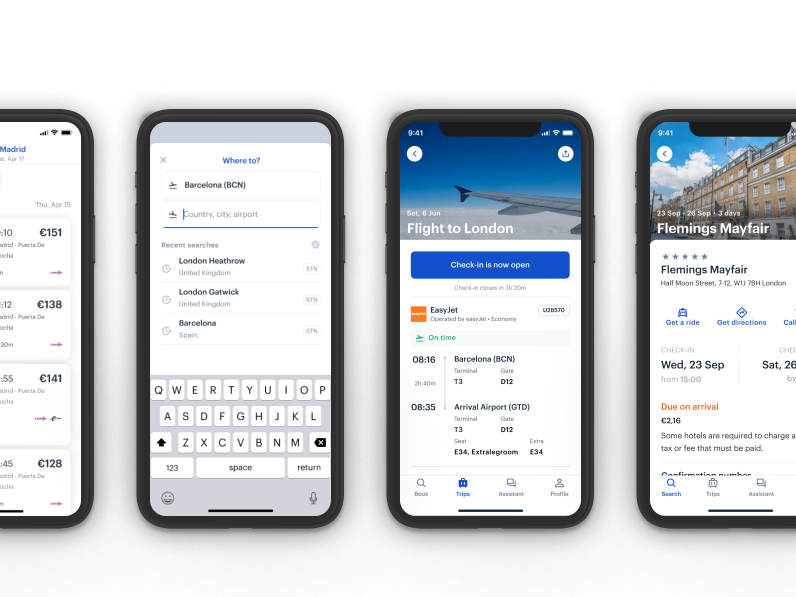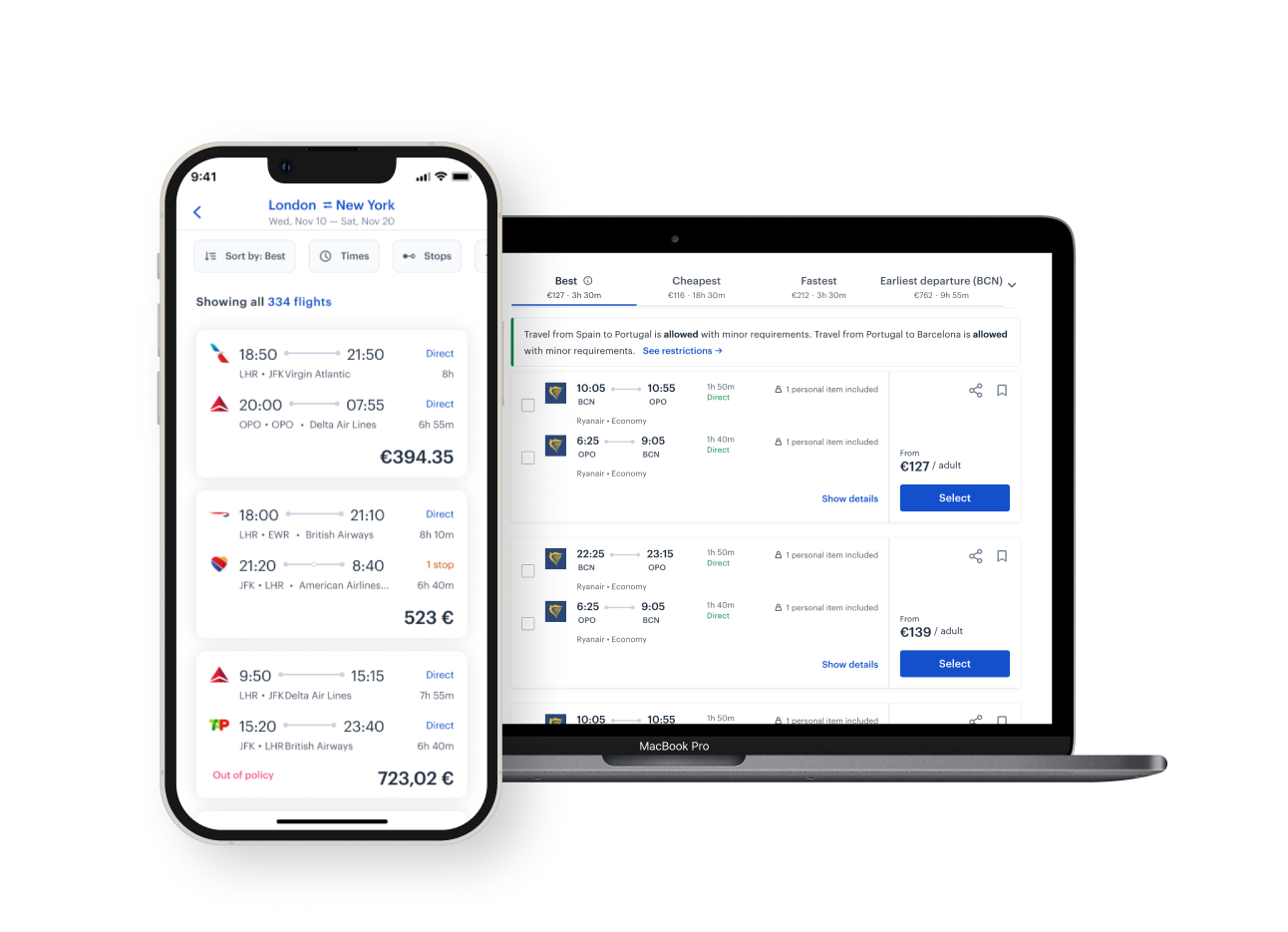Building experiences
at scales
Designing for large-scale and complex projects has inevitably led to Design Systems becoming common practice in today’s leading companies — many of them adopting different variations of the concept in order to maintain design integrity and scalability across their ever-evolving products and platforms, It can be easy to assume that everyone needs a design system, that you can pick one off the shelf or put one together pretty quickly, and your problems are over.
Like many things, a design system isn’t ever a finished thing — it’s a journey.
For the last two years, I’ve been leading the design of the TravelPerk mobile app.
With it, we have been exploring different visual directions of the app, coming up with new usability patterns while delivering features. The mobile design team at TravelPerk is still tiny and growing daily. There are around twenty people who contribute to our designs in some way. Whether they’re commenting on our latest iterations, fixing copy, or designing cross-platform features.
We’ve already been able to rely on our ongoing UiKit for some time now, but we’re still revising and modifying as we go. We expect this will always be the case as we encounter new reasons to add components to our library or modify what exists, but it reached a point where it was essential to define a shared system that would avoid fragmentation and make us more efficient.

Design conventions differ from platform to platform.Native apps aren’t the web, and we found it essential to consider this from the beginning of the app.
The web is an amazing medium, but it is not the only way our customers interact with our products
These differences in convention can affect the user’s ability to understand the UI or complete certain tasks.
Having an open design system is critical for a fast-growing company like ours. Moreover, building such a thing will bring various benefits like faster time-to-market, better internal communication, alignment between contributors, and consistency across our iOS and Android.
Our app runs on iOS and Android, and we want to be good platform citizens. Therefore, it should look like it belongs on the user’s device. While the lines between web and native apps continue to blur, they both have benefits and trade-offs. The users expect a different experience from native apps, a more seamlessly integrate with their device. By thinking carefully about each platform, we create a design system that feels just right for iOS and Android that brings alongside the TravelPerk feeling and aesthetics.

Designing a product for multiple platforms poses a variety of nuanced challenges. iOS, Android, and Web, contain their own unique guidelines, users, and devices.
The design should be subtly adapted to follow the conventions of each platform. We need to know the different types of UI that can be accomplished on each platform, the APIs that support it, and how they could affect performance.

From the start, I firmly believed that the key to our design system’s is the unification of UX/UI across both platforms allowing the system to be easily maintained on the design and development sides as we wish to have a more branded and coherent experience, not two different apps as we have users that use both OS.
Such an approach required a fair amount of convincing because most people are loyal to their platform of choice.

Although most components would become unified, some were deliberately left as “native” to keep the familiarity associated with each platform. Here is an example of our custom top navigation that conforms to native guidelines but uses the TravelPerk brand.
Some other components evolved into “hybrid” versions that mixed custom elements with platform-specific ones.
By thinking carefully about each platform we target, we can create a design system that feels just right for iOS and Android.
Key achievements
As I scaled up the design team and our product process matured, we gradually built out and strengthened our design system to allow us to work efficiently at scale. We needed a strong Design system for many reasons, mostly to prevent new designers and engineers unkowingly spending time redesigning and building out solutions to which we had already solved for.
93 Comments
Comments are closed.

cialis and pay pal
cialis and pay pal
weight loss after zoloft
weight loss after zoloft
flagyl faydaları
flagyl faydaları
escitalopram qt
escitalopram qt
cephalexin kidney infection
cephalexin kidney infection
gabapentin pmdd
gabapentin pmdd
low dose fluoxetine autism
low dose fluoxetine autism
lexapro and alcohol
lexapro and alcohol
viagra 25 mg online
viagra 25 mg online
duloxetine and prednisone
duloxetine and prednisone
can you take gabapentin and cymbalta together
can you take gabapentin and cymbalta together
keflex and clindamycin for cellulitis
keflex and clindamycin for cellulitis
ciprofloxacin uti dose
ciprofloxacin uti dose
cephalexin dogs
cephalexin dogs
bactrim dose
bactrim dose
can bactrim cause headaches
can bactrim cause headaches
neurontin major side effects
neurontin major side effects
can you drink on amoxicillin
can you drink on amoxicillin
ezetimibe drug info
ezetimibe drug info
ddavp in haemophilia a
ddavp in haemophilia a
augmentin interactions
augmentin interactions
generic name for flexeril
generic name for flexeril
diclofenac sodium topical
diclofenac sodium topical
can flomax cause irregular heartbeat
can flomax cause irregular heartbeat
diltiazem 24hr er 180 mg cap
diltiazem 24hr er 180 mg cap
effexor horrible side effects
effexor horrible side effects
depakote dosage
depakote dosage
contrave ja chegou no brasil
contrave ja chegou no brasil
blood pressure medicine cozaar
blood pressure medicine cozaar
citalopram vs prozac
citalopram vs prozac
amitriptyline half life
amitriptyline half life
medication allopurinol
medication allopurinol
aripiprazole 2 mg
aripiprazole 2 mg
aspirin side effects
aspirin side effects
baclofen high how many to get high
baclofen high how many to get high
buspar dosage for panic attacks
buspar dosage for panic attacks
natures way ashwagandha
natures way ashwagandha
celecoxib pill
celecoxib pill
can i give my dog augmentin 875
can i give my dog augmentin 875
side effects celebrex
side effects celebrex
adderall and celexa
adderall and celexa
robaxin and hydrocodone
robaxin and hydrocodone
remeron withdrawal symptoms
remeron withdrawal symptoms
can you buy protonix over the counter
can you buy protonix over the counter
repaglinide prandin and nateglinide starlix
repaglinide prandin and nateglinide starlix
semaglutide kidney pain
semaglutide kidney pain
actos schedule
actos schedule
acarbose bayer
acarbose bayer
abilify vs vraylar
abilify vs vraylar
synthroid side
synthroid side
voltaren gel prn
voltaren gel prn
is sitagliptin a glp-1
is sitagliptin a glp-1
tamsulosin effet indesirable
tamsulosin effet indesirable
quitting spironolactone side effects
quitting spironolactone side effects
can i take venlafaxine at night
can i take venlafaxine at night
buy ivermectin cream
buy ivermectin cream
tizanidine hcl 4 mg capsule
tizanidine hcl 4 mg capsule
… [Trackback]
[…] Find More on to that Topic: marcodasilva.pt/2022/08/14/tkdsystem/ […]
viagra us pharmacy online
viagra us pharmacy online
how many mg of sildenafil should i take
how many mg of sildenafil should i take
buy generic levitra online
buy generic levitra online
cialis online pills
cialis online pills
rhinocort online pharmacy
rhinocort online pharmacy
what does sildenafil do
what does sildenafil do
what’s the difference between sildenafil and tadalafil
what’s the difference between sildenafil and tadalafil
buy levitra next day delivery
buy levitra next day delivery
buy ivermectin for humans uk
buy ivermectin for humans uk
generic viagra free shipping
generic viagra free shipping
vardenafil interactions
vardenafil interactions
ivermectin price comparison
ivermectin price comparison
vardenafil levitra staxyn
vardenafil levitra staxyn
generic ivermectin for humans
generic ivermectin for humans
compare viagra prices uk
compare viagra prices uk
tadalafil 20 mg
tadalafil 20 mg
ivermectin humans
ivermectin humans
ivermectin 3
ivermectin 3
what is tadalafil?
what is tadalafil?
ivermectin 3 mg dose
ivermectin 3 mg dose
gabapentin generic name
gabapentin generic name
metronidazole gel vaginal
metronidazole gel vaginal
isoelectric point of ampicillin
isoelectric point of ampicillin
tamoxifen
tamoxifen
how metformin works
how metformin works
lisinopril ruined my life
lisinopril ruined my life
cymbalta and lyrica together for nerve pain
cymbalta and lyrica together for nerve pain
how much valtrex should i take during an outbreak
how much valtrex should i take during an outbreak
does keflex treat sinus infection
does keflex treat sinus infection
can i drink alcohol while taking cephalexin
can i drink alcohol while taking cephalexin
does ciprofloxacin treat uti
does ciprofloxacin treat uti
trazodone for sleep and anxiety
trazodone for sleep and anxiety
can you drink alcohol with doxycycline
can you drink alcohol with doxycycline
symptoms to get provigil
symptoms to get provigil
is amoxicillin safe during pregnancy
is amoxicillin safe during pregnancy